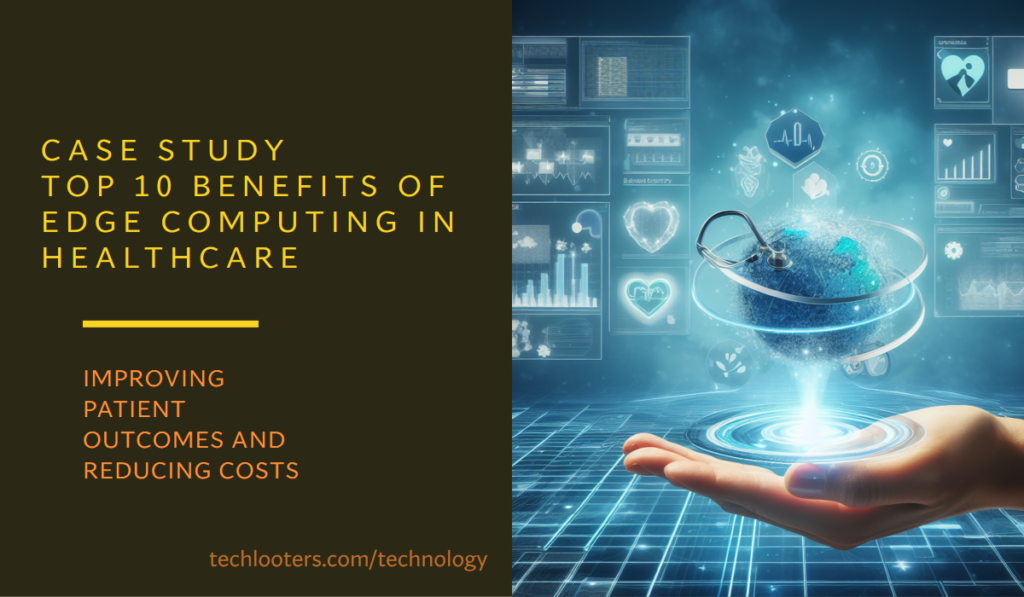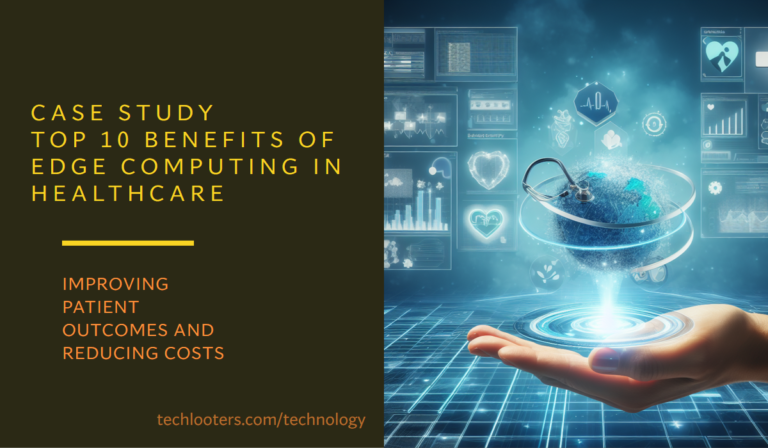Introduction to Edge Computing in Healthcare
Edge computing in healthcare represents a significant shift in how medical data is processed and utilized. It involves processing data at or near the location where it's generated – in clinics, hospitals, or even directly on patient devices outside of clinical settings. This approach contrasts with traditional cloud computing, where data is sent to remote servers for processing. By enabling data processing closer to the source, edge computing enhances the speed and efficiency of healthcare services.
Edge Computing in healthcare plays a crucial role in supporting clinical decision-making. Modern health systems are integrating this technology to improve patient care. This integration has led to the introduction of various medical devices, ranging from wearables to AI-powered imaging systems. These devices provide real-time data, like heart rate or blood pressure, which are essential for timely intervention in patient care.

One of the key advantages of edge computing in healthcare is its ability to bring data processing and analytics closer to where data is generated. This proximity is crucial in scenarios like remote patient monitoring or emergency care where quick decision-making based on real-time data is vital. For instance, AI-enabled imaging models at the edge can expedite the review process for radiologists by prioritizing critical images. Similarly, wearables and health monitors can send crucial patient data to relevant medical devices, aiding in more efficient patient care management.
In addition to improving patient care, edge computing offers significant financial and operational benefits. By processing data locally, healthcare providers can manage the unprecedented volumes of data generated by various medical devices more efficiently. This local processing reduces bandwidth costs and helps in maintaining privacy and compliance with regulations like HIPAA, which is vital for handling sensitive health information.
Moreover, edge computing in healthcare is not just about processing data but also about enhancing the capabilities of cloud computing. It enables healthcare providers to strategically use cloud or edge computing based on needs, costs, and benefits. This flexible approach allows for optimized data management, which is increasingly important as healthcare systems deal with growing amounts of data.
Real-time Patient Monitoring with Edge Computing
Edge Computing in healthcare is revolutionizing real-time patient monitoring by bringing computation and data storage closer to where it is needed. This technology enables healthcare providers to collect and analyze patient data in real-time, enhancing the accuracy and efficiency of patient care and telemedicine.
- Enhanced Surgical Procedures: Edge computing, combined with AI technologies, is transforming surgical procedures. It enables ultra-low latency streaming of surgical video into AI-powered data processing workflows, aiding surgeons in identifying anomalies, making automatic measurements, and monitoring vital aspects during surgery. This technology ensures that procedures are minimally invasive and improves patient recovery times.
- Telemedicine Advancements: Telemedicine has been greatly enhanced by edge computing, allowing healthcare providers to offer services remotely. It enables real-time data processing and analysis, critical in emergency situations where quick decision-making is necessary. For instance, in cases of heart attacks, edge computing can aid in faster diagnosis and treatment, potentially saving lives.
- Smart Hospital Integration: Hospitals are integrating edge computing into various technologies, such as patient monitoring systems, patient screening, and conversational AI. It can identify patients at risk, like those likely to fall from a hospital bed, and promptly alert nursing staff. Body pose estimation AI models, for instance, can monitor patient movements and prevent falls by providing real-time data analytics at the bedside.
- Improving Device Accuracy: Edge computing also improves the accuracy of medical devices like blood glucose and blood pressure monitors. By calibrating these devices in real-time, edge computing ensures accurate readings, crucial for patients with chronic conditions such as diabetes or hypertension.
- Enhancing Privacy and Security: Since edge computing processes and analyzes patient data locally, it reduces the risk of data breaches, ensuring higher levels of patient data confidentiality and security. This is particularly important in healthcare, where data sensitivity is paramount.
- Remote Monitoring Efficiency: Edge computing enhances remote monitoring by reducing latency and improving data collection accuracy. It allows healthcare providers to effectively monitor patients’ health status remotely, reducing the need for in-person visits and thereby improving patient outcomes.

Connected Ambulances: How Edge Computing is Revolutionizing Emergency Care
Connected ambulances, enhanced by edge computing and 5G technology, are significantly transforming emergency medical services (EMS). These advancements are creating a new era of efficient and effective pre-hospital care by optimizing communication, diagnostics, and treatment in transit.
Enhanced Communication and Diagnostics
The integration of 5G technology in ambulances provides low-latency, high-bandwidth capabilities essential for real-time communication and data transfer. For example, smart ambulance systems developed by companies like Excelerate and Visionable enable seamless data transfer between ambulances and hospitals. This technology allows medical professionals in the ambulance to connect with hospital staff via video link, enabling consultations and diagnoses to begin before the patient reaches the hospital. This is particularly effective in stroke patients, where every minute counts. The technology has been found to reduce the time to treatment, significantly improving patient outcomes.
Smart Equipment and IoT Integration
Ambulances are equipped with advanced medical devices, such as remote ECG machines, that can communicate directly with hospital systems, transmitting results in real-time. This allows for more accurate diagnoses and treatment plans to be made en route. With the support of technologies like AR and VR, paramedics can also receive guidance from remote clinicians to perform emergency procedures.
Network Slicing for Reliable Connectivity
The use of network slicing in 5G technology, as demonstrated by Chunghwa Telecom in collaboration with Ericsson, ensures isolated network slices for ambulances. This feature allows for the seamless transmission of real-time patient data and high-resolution 4K videos, facilitating remote diagnosis and decision-making. Network slicing ensures that patient information is available to clinicians through a high-speed and stable network, leading to more efficient care.
Advanced Navigation and RFID Technology
Smart ambulances utilize GPS for real-time traffic monitoring to optimize routes, ensuring the fastest possible response time. Additionally, RFID technology is employed to track medical equipment, monitor expiration dates, and ensure timely restocking. This reduces the time needed for inventory management, allowing EMS teams to focus more on patient care.

Remote patient monitoring (RPM) with edge computing
Remote patient monitoring (RPM) with edge computing in healthcare is increasingly being recognized as a transformative approach. Edge computing allows for real-time data processing and analysis close to the source of data generation, such as medical devices like glucose monitors and blood pressure cuffs. This technology is particularly crucial for applications requiring rapid data analysis and decision-making, like medical imaging and emergency situations. For instance, the transmission of large medical images, which can be between 3GB to 6GB each, to centralized servers is often too slow and costly for cloud computing. Instead, edge computing processes these images quickly and efficiently, directly at the point of care, enhancing the speed and quality of medical interventions.
| Year | Market Value | Growth Rate/CAGR | Source |
|---|---|---|---|
| 2022 | $4.1 billion | - | SkyQuest Technology |
| 2028 | $12.9 billion | 26.1% from 2022 to 2028 | MarketsandMarkets |
| 2025 (Prediction) | 75% of data generated at the edge | - | Dell Technologies |
| 2032 | $43.29 billion | - | Yahoo Finance |
Edge computing in healthcare anticipated to grow significantly, reflecting its potential to transform patient care delivery. Edge computing in healthcare is still in its early stages., but its integration into medical devices is already evident, with devices like cardiac monitors acting as edge computing units. This integration blurs the lines between medical and IT equipment, paving the way for more advanced and efficient healthcare services.

Improved Clinician Support with Edge Computing in Healthcare
Edge computing in healthcare is playing a pivotal role in enhancing clinician support, offering significant advancements in the way medical care is delivered and managed. Here's an overview of how edge computing is transforming clinician support:
- Real-time Data Processing and Analysis: Edge computing allows for the immediate processing and analysis of medical data. This is particularly beneficial in emergency situations where quick decision-making is crucial. For instance, in medical imaging, large files such as 3GB to 6GB radiology images can be processed locally rather than being sent to the cloud, reducing latency and speeding up the delivery of critical care.
- AI-Powered Medical Devices: The integration of AI with edge computing in medical devices enhances the capabilities of clinicians. For example, AI-augmented medical devices help surgeons identify anomalies, track surgical tools, and monitor patients in real time during procedures, improving the outcomes of surgeries. These AI-driven insights ensure procedures are minimally invasive and aid in faster patient recovery.
- Enhanced Patient Monitoring: Smart hospitals are utilizing edge computing to integrate AI workflows into various technologies for patient monitoring. These technologies can identify patients at risk of incidents like falls and notify nursing staff immediately, ensuring prompt and efficient care. The utilization of human pose estimation and computer vision at the bedside provides real-time data analytics, enhancing patient safety and care.
- Remote Care and Chronic Disease Management: Edge computing facilitates effective remote patient monitoring and chronic disease management. Platforms like the HARMAN Remote Care Platform, which uses Intel® architecture, allow for the connection of a wide array of medical and non-medical devices. This enables continuous care for patients and the elderly at home, reducing hospital readmissions and cutting healthcare costs.
- Streamlining Patient Registration and Experience: Projects like Geisinger's pilot platform, which uses automation and facial recognition technologies, demonstrate how edge computing can streamline patient experiences. By turning patients' smartphones into edge computing devices, the process from registration to receiving medical care becomes more efficient, reducing physical contact points and resource usage.
- Data Security and Compliance: With the sensitivity of healthcare data, edge computing provides a more secure environment compared to centralized cloud storage. The real-time data transmission with edge computing undergoes rigorous security scrutiny, aligning with healthcare regulations like HIPAA, thus ensuring patient data privacy and security.
Equitable Healthcare Access with Edge Computing in Healthcare
Edge computing is significantly enhancing equitable healthcare access by enabling efficient and cost-effective digital health solutions, particularly in remote and underserved areas. The utilization of edge computing in the healthcare sector focuses on processing digital health data at the edge, close to where it's generated, which minimizes the data exchange with central servers or the internet. This approach not only improves privacy but also reduces the requirement for expensive infrastructure in isolated and rural areas. By incorporating intelligent edge device shadows, edge computing can play a crucial role in affordable data collection processes in such regions, making healthcare more accessible.
Additionally, edge computing aids in the distribution and collaborative management of information in digital healthcare systems. This is particularly relevant in the era of the Internet of Medical Things (IoMT), where a large volume of health records is being generated. Processing this data at the edge ensures timely and efficient handling of healthcare information, which is crucial for patient care.
Furthermore, with the growing trend of healthcare services moving out of hospitals and into clinics, retail locations, and homes, edge computing provides the necessary tools for on-site, real-time medical assessments. This shift in healthcare delivery, supported by edge computing, is instrumental in making healthcare services more accessible to a broader population.
Benefits of Edge Computing in healthcare

The implementation of edge computing in healthcare, while bringing numerous benefits, also faces several challenges:
- Integration of Diverse Devices: One significant challenge is integrating various types of edge devices like medical sensors and wearables. These devices often use different technologies that don't inherently communicate with each other, necessitating the development of common standards and protocols to ensure seamless integration and communication.
- Data Security and Privacy Concerns: Ensuring robust security measures to protect sensitive patient data processed on edge devices is crucial. This includes implementing stringent data encryption, access controls, and secure communication protocols. Compliance with healthcare data regulations such as HIPAA is vital to maintain patient privacy, even in edge-based healthcare analytics.
- Complexity of Optimal Computing Techniques: Healthcare organizations must implement optimal computing techniques like encryption, authentication, and classification on devices used in edge computing architecture. The classification of health data involving vital signs monitoring, activity, and fall detection is particularly crucial in edge computing applications.
- Ensuring Efficient Medical Diagnosis: An innovative framework that integrates distributed ledger technology (DLT), artificial intelligence (AI), and edge computing is crucial for creating a robust and reliable medical ecosystem. This involves managing patients’ health data securely using a combination of elliptic curve cryptography-based identity-based cryptosystems and edge nodes, ensuring both privacy and integrity.
- Maintaining Real-time Data Analysis and Patient Care: The capability of edge computing to enable real-time data analysis represents a challenge in maintaining the speed and efficiency of healthcare operations. Healthcare providers must gain immediate insights into patient conditions and treatment effectiveness by processing data on-site.
- Predictive Analytics and Diagnostics: The role of edge computing in predictive analytics and diagnostics is challenging yet crucial. It involves utilizing edge devices rather than traditional data sources for the most up-to-date data, enabling predictive algorithms to forecast emerging health trends and improve diagnostic accuracy.
Edge Computing Vs Cloud Computing in healthcare
| Aspect | Edge Computing | Cloud Computing |
|---|---|---|
| Data Processing Location | Near the source of data | Remote data centers |
| Latency | Low latency | Higher latency |
| Data Security | Enhanced (local processing) | Potential risks during data transmission |
| Cost | Variable, often lower due to reduced data transmission | Higher due to data storage and transmission costs |
| Scalability | Limited by local resources | Highly scalable |
| Real-Time Analysis | Enables real-time data analysis | Delayed due to data transmission time |
| Complexity | Higher for deployment and maintenance | Simpler initial setup |
| Reliability | Depends on local infrastructure | High, relies on robust data center infrastructure |
The future of edge computing in healthcare

The future of edge computing in healthcare is shaping up to be both transformative and instrumental in advancing patient care. Key trends and developments in this area include:
- Real-time Data Processing and Analytics: Edge computing facilitates the real-time processing of health data, crucial for remote monitoring of vital signs and enabling immediate action in critical care scenarios. This capability is essential in situations where every second counts, such as in emergency response and real-time patient monitoring.
- Integration with 5G Technology: The combination of edge computing with the rollout of 5G networks will greatly enhance healthcare services. This synergy is expected to revolutionize healthcare by enabling faster data processing, reduced latency, and improved connectivity, even in remote areas. The potential for real-time, low-latency applications is particularly significant in areas like robotic surgeries and remote patient monitoring.
- Enhanced Patient Experience: The use of edge computing in healthcare is anticipated to improve patient experiences significantly. By providing immediate access to data and enhancing the precision of diagnoses, edge computing enables more personalized care. This approach is likely to be more patient-centric, with a focus on real-time care delivery and management.
- AI and Machine Learning Integration: Edge computing is expected to increasingly integrate with AI and machine learning algorithms to enhance healthcare services. This integration could lead to more effective predictive analytics, better disease detection, and improved decision-making in treatment plans. AI-enabled edge devices can process large amounts of data locally, leading to faster and more accurate medical insights.
- Cost Reduction and Operational Efficiency: The use of edge computing can lead to significant cost savings for healthcare organizations. By reducing the dependence on cloud computing and central servers, edge computing can lower operational costs. Additionally, technologies like IoT and wearables can help healthcare organizations save costs related to security and surveillance.
- Security and Compliance Challenges: Despite the many benefits, implementing edge computing in healthcare comes with challenges, particularly regarding data security and compliance with regulations like HIPAA. Healthcare organizations will need to employ robust security measures and comply with stringent data handling requirements to ensure patient privacy and data protection.
The future of edge computing in healthcare is marked by its potential to enhance real-time data processing, improve patient care, integrate with emerging technologies like AI and 5G, and offer cost-effective solutions. However, addressing the challenges related to security and compliance will be crucial for its successful implementation.
References
- MIT Technology Review - Transforming health care at the edge
- Computerworld - The cutting edge of healthcare: How edge computing will transform medicine
- Healthcare IT News - Healthcare's edge computing priorities have changed
- Intel - How Edge Computing Is Driving Advancements in Healthcare
- TCS - Edge Computing in Healthcare to Realize Value-based Real-time Care




